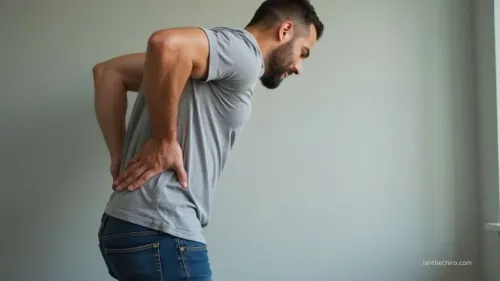Davis's Law: How Your Soft Tissues Adapt (And Why Regular Movement Matters)
Thanks to Davis’s Law, your soft tissues, like ligaments and tendons, adapt to the stresses you place on them.
If you move and stretch regularly, these tissues get stronger, more flexible, and resistant to injury because collagen fibers realign and remodel with gentle, steady tension. But when you stay inactive, tissues stiffen and shorten, raising your risk for pain and injury. Building smarter movement habits helps you keep tissues healthy and resilient.
Want to know how to use this to your advantage?
The Origins and Principles of Davis's Law

Although many people are familiar with how bones adapt to stress, fewer realise that your soft tissues also respond to mechanical forces, a concept known as Davis’s Law. Named after orthopedic surgeon Henry Gassett Davis in the late 19th century, this law explains that soft tissues like fascia, ligaments, & tendons remodel in response to sustained mechanical stress.
When you apply gentle, consistent tension, your tissues gradually lengthen and adapt to meet functional demands. This principle is foundational in physical therapy and rehabilitation, helping guide effective recovery strategies.
Just as Wolff’s Law describes bone adaptation, Davis’s Law shows that your body’s soft tissues thrive on movement and respond to how you use them. Understanding this can help you maintain flexibility, promote healing, and prevent injuries.
How Soft Tissues Respond to Mechanical Stress
When you place consistent, controlled stress on your soft tissues, like ligaments, tendons, and fascia, they don’t just stretch temporarily; they actually start to adapt at a cellular level.
Mechanical stress signals these tissues to gradually elongate and reorganise their collagen fibers, making them stronger and more flexible over time. Regular stretching and movement encourage the fibers to align in the direction of force, which helps your soft tissues better resist and distribute future stresses.
If you stay active and apply appropriate, progressive loads, you’ll notice lasting improvements in range of motion and resilience.
On the flip side, avoiding movement or immobilising a joint allows soft tissues to tighten and lose elasticity, limiting mobility and making them more prone to injury.
Davis's Law and the Cumulative Injury Cycle

Consistent mechanical stress shapes the way your soft tissues adapt, but if that stress becomes repetitive or improper, like poor posture or overuse, you risk setting off the cumulative injury cycle described by Davis’s Law.
When you expose your ligaments, tendons, and fascia to chronic strain or poorly managed healing, they respond by forming adhesions and scar tissue. These changes reduce flexibility and mobility, making your soft tissues more vulnerable to further injury.
Each time you reinjure the area, the cycle repeats, causing more thickening and dysfunction. Over time, this injury cycle weakens your tissues and increases your risk of ongoing pain or impairment.
Managing mechanical stress and moving appropriately is essential to prevent maladaptive remodeling and break this destructive cycle before it becomes chronic.
Practical Applications in Injury Prevention and Rehabilitation
By applying Davis’s Law in your daily routine, you can take concrete steps to prevent injuries and support effective rehabilitation. Focus on gentle, consistent movement, like stretching or controlled exercises, to encourage soft tissue adaptation.
Gradually increasing tension through these activities helps ligaments and tendons remodel, reducing injury risk and supporting flexibility. If you’re recovering from an injury, progressive loading is key; it stimulates tissue regeneration and prevents adhesions that limit mobility.
Understanding how soft tissues respond to mechanical stress lets you and your clinician design exercise routines that promote healing while minimising the chance of re-injury.
The Importance of Movement for Long-Term Tissue Health

Although it’s easy to overlook, regular movement is essential for keeping your soft tissues healthy and resilient over time. When you keep your body active, you stimulate your ligaments, tendons, and fascia to adapt by aligning collagen fibers, which boosts flexibility and functional strength.
Consistent movement also helps prevent the formation of adhesions and restrictions, supporting ongoing tissue remodeling and ideal fascial health. Without enough movement, your tissues can shorten and become rigid, making it harder to move and increasing your risk of injury.
Studies show that tissues exposed to regular, dynamic loading adapt by increasing their tensile strength and elasticity. By making movement a daily habit, you’ll support long-term tissue health, prevent degeneration, and keep your body functioning at its best.
Frequently Asked Questions About Davis’s Law
What Is the Davis Law of Soft Tissue Adaptation?
You should know Davis's Law says your soft tissues adapt to the demands you place on them. If you move and stretch regularly, your tissues strengthen and stay flexible. If you don’t, they’ll stiffen and weaken.
What Is the Davis Law of Adaptation?
You know the saying, “Use it or lose it”? Davis’s Law shows it’s true for your soft tissues. When you move regularly, your ligaments and tendons adapt, becoming stronger and more flexible, reducing your injury risk.
What Is the Davis's Law Explained?
Davis's Law says your soft tissues adapt to the stresses you place on them. If you move regularly and stretch properly, you'll keep tissues flexible and strong. Neglect movement, and you'll risk tightness, weakness, and injury.
What Is the Davis Law of Tissue Healing?
When it comes to tissue healing, you can't just sit on your hands, Davis's Law says your soft tissues actually remodel and strengthen with gentle, consistent movement. Evidence shows regular, appropriate activity speeds healing and keeps tissues flexible and resilient.
Conclusion: Why Consistent Movement Matters for Tissue Resilience
Now that you know Davis’s Law is more than just a theory, studies confirm your soft tissues truly adapt to how you move, you’ve got the power to shape your body’s resilience.
Don’t underestimate the impact of daily movement. By staying active and varying your activities, you’ll keep your tissues strong, flexible, and pain-free. So, make movement a non-negotiable part of your routine.
Your body will thank you for it, both now and for years to come.














